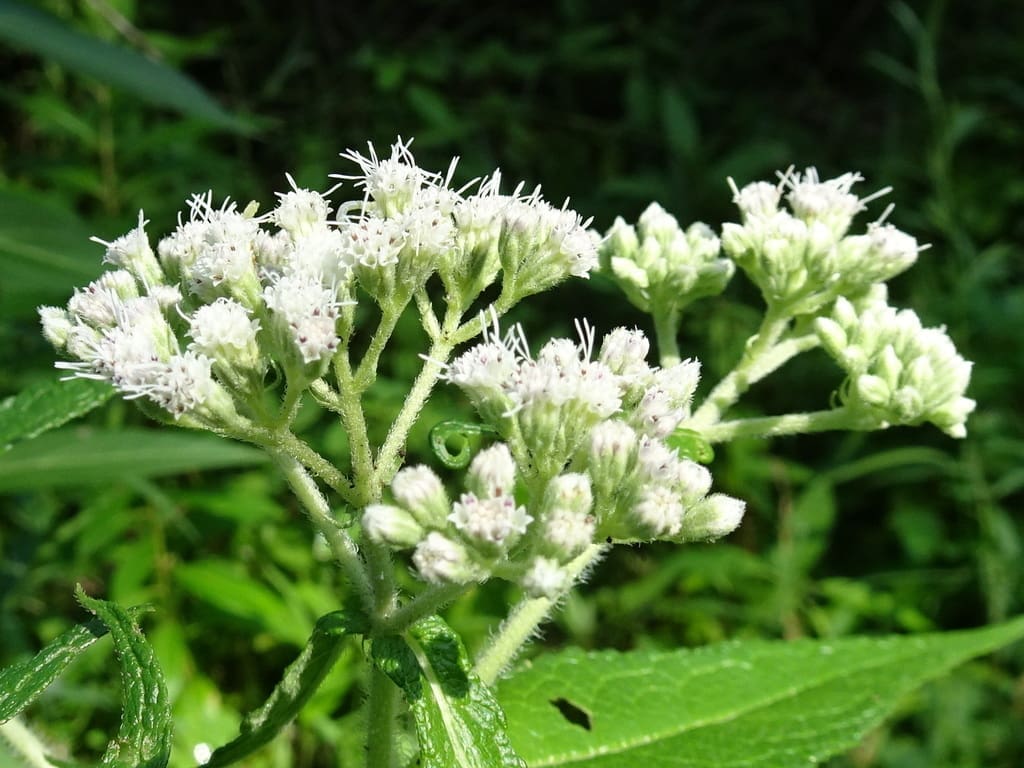
Eupatorium perfoliatum
Latin name: Eupatorium perfoliatum
Short name: Eup-per
Common name: Boneset | Thoroughwort | Indian Sage | Ague Weed | Sweating Plant
Primary miasm: Acute Secondary miasm(s): Psoric, Malarial
Kingdom: Plants
Family: Asteraceae
- Symptomatology
- Remedy Information
- Differentiation & Application
Eupatorium perfoliatum is a native North American plant in the Asteraceae family. Its leaves grow “through” the stem—hence the name “perfoliatum.” Traditionally used by Native Americans for febrile illnesses, it was known for inducing profuse sweat and easing the pain of “break-bone fever.”
Historically used as a diaphoretic and emetic in herbal medicine to treat influenza, malaria, and rheumatic fevers. It was also taken as a hot infusion to promote sweating and clear mucus.
Proved by Dr. William E. Payne and introduced into homeopathy by Dr. C. Hering. Proving symptoms confirmed by Hering and Hale.
- Bones and periosteum – aching, bruised, or broken sensation
- Muscles – deep soreness, especially in limbs
- Liver – congestion, jaundice, dull ache
- Respiratory tract – bronchitis, influenza, rattling cough
- Stomach and digestion – nausea with chill, bitter vomiting
- Spleen – fullness, aching in malaria-type fevers
- Circulation – chill, fever, sweat cycle with marked periodicity
- Profuse perspiration
- Lying with head high
- Being covered warmly
- Rest in a warm room
- Vomiting bile (relieves nausea)
- Motion or exertion
- Cold air or exposure
- 7–9 a.m. (especially chill and bone pains)
- Open air
- Touch (painful bones and limbs)
- Periodic return of fever
- Arnica – Bruised pains but more from trauma; not periodic
- Bryonia – Pain worse from motion, but lacks marked bone soreness and vomiting
- Rhus tox. – Restlessness and aching, but better for motion and lacks periodic fever
- China (Cinchona) – Malarial remedy with debility, but less bone pain
- Gelsemium – Weakness and chilliness, but more nervous symptoms than pain
- Complementary: Arsenicum album, China, Gelsemium
- Antidotes: Nux vomica, Arsenicum album
- Follows well: Aconite, Bryonia, Nux vomica
- Precedes well: Sulphur, China
Eupatorium perfoliatum is the archetypal remedy for influenza with severe bone and muscle pain—the “boneset” state. It captures the collapse and suffering of febrile illnesses where the patient lies still, tormented by deep aching as if broken. Periodicity, thirst before chill, and relief from vomiting are hallmarks. It is a remedy of systemic suffering, where every structure—bone, muscle, mucosa—feels overwhelmed. The patient is silent, aching, and waiting for the sweat to bring mercy.
- Indispensable in influenza with bone pain
- Use in malaria, dengue, or post-viral syndromes with chill–fever–sweat cycle
- Excellent in bronchitis or pneumonia with bruised chest and violent cough
- Relieves migraine with nausea during fevers
- Effective in intermittent fevers with great thirst and nausea before chill
Mind
- Indifference during fever
- Anxiety before chill
- Dullness with aching pains
Head
- Headache, occipital, during chill
- Throbbing pain, heat during fever
- Pain, motion aggravates
Extremities
- Pain, bones, as if broken
- Aches, long bones
- Pain, limbs, motion aggravates
Back
- Pain, lumbar, before chill
- Soreness, sacrum
- Chills, spine
Fever
- Chill, 7–9 a.m.
- Heat, with thirst
- Sweat, profuse, relieves
Stomach
- Nausea, before chill
- Vomiting, bile
- Thirst, before chill
C. Hering – Guiding Symptoms of Our Materia Medica: Original proving, bone pain and periodic fever
William Boericke – Pocket Manual of Homoeopathic Materia Medica: Clinical use in influenza, cough, and bilious states
James Tyler Kent – Lectures on Homoeopathic Materia Medica: Distinguishing modalities and essence of suffering
John Henry Clarke – Dictionary of Practical Materia Medica: Detailed fever stages and complementary remedies
E. M. Hale – New Remedies: Fever, vomiting, and the classic influenza pattern with “broken bone” sensation
